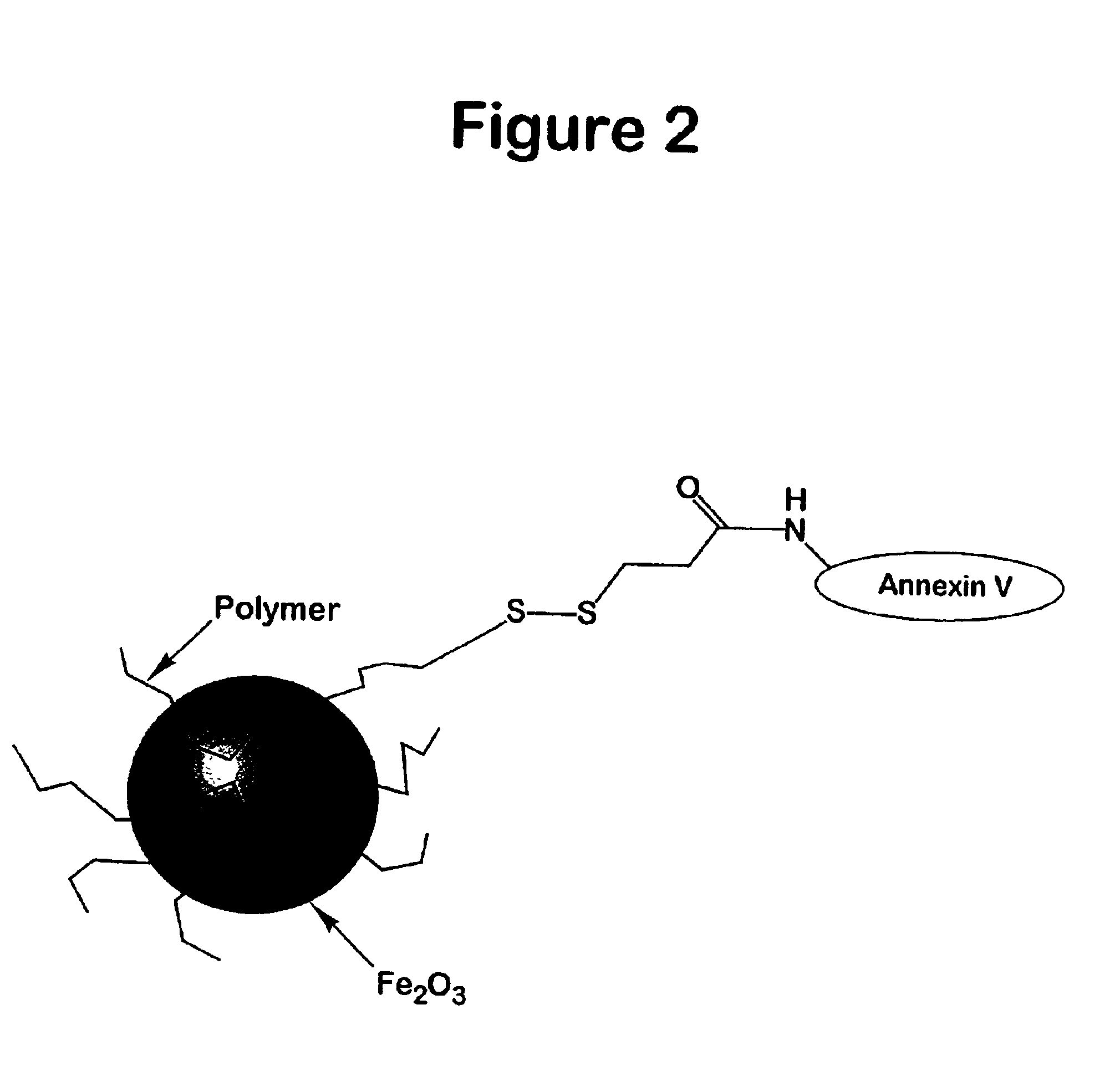Methods for using annexin for detecting cell death in vivo and treating associated conditions
a cell death and apoptosis technology, applied in the direction of magnetic variable regulation, process and machine control, drug compositions, etc., can solve the problems of undesired apoptosis, debilitating and sometimes fatal dysfunction of the affected organ, and apoptosis can have particularly devastating consequences, so as to achieve enhanced radiation delivery, efficient and effective detection, and efficient and effective detection
- Summary
- Abstract
- Description
- Claims
- Application Information
AI Technical Summary
Benefits of technology
Problems solved by technology
Method used
Image
Examples
example 1
Attachment of Annexin V to Dextran Coated Magnetic Iron Oxides Through the Use of Periodate
[0093]Periodate treatment of the dextran coated magnetic particle produces an aldehyde, which forms a Schiff base with the amines of the Annexin V. The complex is stabilized by treatment with sodium borohydride.
[0094]A dextran coated superparamagnetic iron oxide nanoparticle was synthesized according to the methods of Molday (1982) J. Immunol. Methods 52, 353. Iron oxide (10 mg Fe in about 1 mL of water) and purified Annexin V were dialyzed against sodium acetate (0.01M, pH 6). Annexin V was purified by the method of Wood (1996) Blood 88, 1873. The amount of Annexin V can be varied from 1 to about 50 mg, preferably 5-10 mg of protein. At lower amounts the ratio of protein to iron on the resulting magnetic nanoparticle will be lower, but the offered protein will couple more efficiently. At higher amounts of protein, the ratio of protein to iron on the resulting nanoparticle will be higher, but ...
example 2
Attachment of Annexin V with a Sulfhydryl Group to Amino CLIO
[0096]The amino-CLIO nanoparticle was made as described in Josephson (1999) Bioconjug. Chem. 10, 186. Annexin V with a sulfhydryl group added through mutagenesis (Tait (2000) Bioconjug Chem 11, 918) was employed. To 1.2 mL of amino-CLIO in (30 mg Fe) was added 1.2 mL of 0.1 M phosphate buffer, pH 7.4, and 2 mL of N-succinimidyl 3-(2-pyridyldithio)propionate (SPDP, 25 mM) (Molecular Bio-sciences, Boulder, Colo.) in DMSO. The mixture was allowed to stand for 60 minutes at room temperature. Low molecular impurities were removed by PD-10 columns (Sigma Chemical, St- Louis, Mo.) equilibrated with 0.01 M Tris and 0.02 M citrate, pH 7.4 buffer.
[0097]Between 2 and 50 mg of Annexin V was subsequently added to 10 mg Fe of the SPDP activated nanoparticle at room temperature arid the mixture was allowed to stand overnight. The Annexin V-magnetic nanoparticle can be separated from the unreacted annexin by a variety sized based separati...
example 3
Reaction of Annexin V to Add a Sulfhydryl Group, Followed by Reaction with Amino CLIO
[0098]A sulfhydryl group was added to the annexin (obtained as in Example 1) by use of the reagent SATA following the manufacturers instructions, Pierce Chemical Company. Amino-CLIO was reacted with SPDP as in Example 2 and then reacted with the SAT A reacted annexin.
PUM
| Property | Measurement | Unit |
|---|---|---|
| time | aaaaa | aaaaa |
| size | aaaaa | aaaaa |
| size | aaaaa | aaaaa |
Abstract
Description
Claims
Application Information
 Login to View More
Login to View More - R&D
- Intellectual Property
- Life Sciences
- Materials
- Tech Scout
- Unparalleled Data Quality
- Higher Quality Content
- 60% Fewer Hallucinations
Browse by: Latest US Patents, China's latest patents, Technical Efficacy Thesaurus, Application Domain, Technology Topic, Popular Technical Reports.
© 2025 PatSnap. All rights reserved.Legal|Privacy policy|Modern Slavery Act Transparency Statement|Sitemap|About US| Contact US: help@patsnap.com


